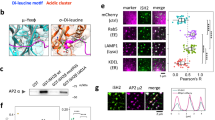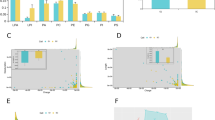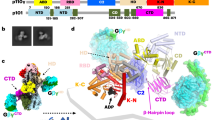Abstract
Phosphoinositide-3-OH kinase (PI(3)K), activated through growth factor stimulation, generates a lipid second messenger, phosphatidylinositol-3,4,5-trisphosphate (PtdIns(3,4,5)P3)1,2,3,4,5. PtdIns(3,4,5)P3 is instrumantal in signalling pathways that trigger cell activation, cytoskeletal rearrangement, survival and other reactions. However, some targets of PtdIns(3,4,5)P3 are yet to be discovered1,2,3,4,5,6,7. We demonstrate that SWAP-70, a unique signalling protein8,9,10, specifically binds PtdIns(3,4,5)P3. On stimulation by growth factors, cytoplasmic SWAP-70, which is dependent on PI(3)K but independent of Ras, moved to cell membrane rearrangements known as ruffles. However, mutant SWAP-70 lacking the ability to bind PtdIns(3,4,5)P3 blocked membrane ruffling induced by epidermal growth factor or platelet-derived growth factor. SWAP-70 shows low homology with Rac-guanine nucleotide exchange factors (GEFs), and catalyses PtdIns(3,4,5)P3-dependent guanine nucleotide exchange to Rac. SWAP-70-deficient fibroblasts showed impaired membrane ruffling after stimulation with epidermal growth factor, and failed to activate Rac fully. We conclude that SWAP-70 is a new type of Rac-GEF which, independently of Ras, transduces signals from tyrosine kinase receptors to Rac.
This is a preview of subscription content, access via your institution
Access options
Subscribe to this journal
Receive 51 print issues and online access
$199.00 per year
only $3.90 per issue
Buy this article
- Purchase on Springer Link
- Instant access to full article PDF
Prices may be subject to local taxes which are calculated during checkout




Similar content being viewed by others
References
Toker, A. & Cantley, L. C. Signalling through the lipid products of phosphoinositide-3-OH kinase. Nature 387, 673–676 (1997).
Downward, J. Role of phosphoinositide-3-OH kinase in Ras signaling. Adv. Second Mess. Phosphoprot. Res. 31, 1–10 (1997).
Martin, T. F. Phosphoinositide lipids as signaling molecules: Common themes for signal transduction, cytoskeletal regulation, and membrane trafficking. Annu. Rev. Cell. Dev. Biol. 14, 231–264 (1998).
Rameh, L. E. & Cantley, L. C. The role of phosphoinositide 3-kinase lipid products in cell function. J. Biol. Chem. 274, 8347–8350 (1999).
Fruman, D. A., Meyers, R. E. & Cantley, L. C. Phosphoinositide kinases. Annu. Rev. Biochem. 67, 481–507 (1998).
Fukui, Y., Ihara, S. & Nagata, S. Downstream of phosphatidylinositol-3 kinase, a multifunctional signaling molecule, and its regulation in cell responses. J. Biochem. (Tokyo) 124, 1–7 (1998).
Vanhaesebroeck, B. et al. Synthesis and function of 3-phosphorylated inositol lipids. Annu. Rev. Biochem. 70, 535–602 (2001).
Borggrefe, T., Wabl, M., Akhmedov, A. T. & Jessberger, R. A B-cell-specific DNA recombination complex. J. Biol. Chem. 273, 17025–17035 (1998).
Borggrefe, T. et al. Cellular, intracellular, and developmental expression patterns of murine SWAP-70. Eur. J. Immunol. 29, 1812–1822 (1999).
Masat, L. et al. Association of SWAP-70 with the B cell antigen receptor complex. Proc. Natl Acad. Sci. USA 97, 2180–2184 (2000).
Borggrefe, T., Keshavarzi, S., Gross, B., Wabl, M. & Jessberger, R. Impaired IgE response in SWAP-70-deficient mice. Eur. J. Immunol. 8, 2467–2475 (2001).
Shirai, R. et al. Synthesis of diacylglycerol analogs of phosphatidylinositol 3,4,5-trisphosphate. Tetrahedron Lett. 39, 9485–9488 (1998).
Staal, S. Molecular cloning of the akt oncogene and its human homologues AKT1 and AKT2: amplification of AKT1 in a primary human gastric adenocarcinoma. Proc. Natl Acad. Sci. USA 84, 5034–5037 (1987).
Tanaka, K. et al. A target of phosphatidylinositol 3,4,5-trisphosphate with a zinc finger motif similar to that of the ADP-ribosylation-factor GTPase-activating protein and two pleckstrin homology domains. Eur. J. Biochem. 245, 512–519 (1997).
Maekawa, M. et al. A novel mammalian Ras GTPase-activating protein which has phospholipid-binding and Btk homology regions. Mol. Cell. Biol. 14, 6879–6885 (1994).
Campbell, D. & Kernan, J. Mast cells in the central nervous system. Nature 210, 756–757 (1966).
Thomas, J. et al. Colocalization of X-linked agammaglobulinemia and X-linked immunodeficiency genes. Science 261, 355–358 (1993).
Han, J. et al. Role of substrates and products of PI 3-kinase in regulating activation of Rac-related guanosine triphosphatases by Vav. Science 279, 558–560 (1998).
Fleming, I. N., Gray, A. & Downes, C. P. Regulation of the Rac1-specific exchange factor Tiam1 involves both phosphoinositide 3-kinase-dependent and -independent components. Biochem. J. 351, 173–182 (2000).
Das, B. et al. Control of intramolecular interactions between the pleckstrin homology and Dbl homology domains of Vav and Sos1 regulates Rac binding. J. Biol. Chem. 275, 15074–15081 (2000).
Joly, M., Kazlauskas, A., Fay, F. S. & Corvera, S. Disruption of PDGF receptor trafficking by mutation of its PI-3 kinase binding sites. Science 263, 684–687 (1994).
Martin, S. S. et al. Phosphatidylinositol 3-kinase is necessary and sufficient for insulin-stimulated stress fiber breakdown. Endocrinology 137, 5045–5054 (1996).
Wennstrom, S. & Downward, J. Role of phosphoinositide 3-kinase in activation of ras and mitogen-activated protein kinase by epidermal growth factor. Mol. Cell. Biol. 19, 4279–4288 (1999).
Missy, K. et al. Lipid products of phosphoinositide 3-kinase interact with Rac1 GTPase and stimulate GDP dissociation. J. Biol. Chem. 273, 30279–30286 (1998).
Scita, G. et al. EPS8 and E3B1 transduce signals from Ras to Rac. Nature 401, 290–293 (1999).
Iwamatsu, A. S-carboxymethylation of proteins transferred onto polyvinylidene difluoride membranes followed by in situ protease digestion and amino acid microsequencing. Electrophoresis 13, 142–147 (1992).
Tanaka, K. et al. Evidence that a phosphatidylinositol 3,4,5-trisphosphate-binding protein can function in nucleus. J. Biol. Chem. 274, 3919–3922 (1999).
Kita, Y. et al. Microinjection of activated phosphatidylinositol-3 kinase induces process outgrowth in rat PC12 cells through the Rac-JNK signal transduction pathway. J. Cell Sci. 111, 907–915 (1998).
Lenzen, C., Cool, R. & Wittinghofer, A. Analysis of intrinsic and CDC25-stimulated guanine nucleotide exchange of p21ras-nucleotide complexes by fluorescence measurements. Methods Enzymol. 255, 95–109 (1995).
Zheng, Y., Bagrodia, S. & Cerione, R. Activation of phosphoinositide 3-kinase activity by Cdc42Hs binding to p85. J. Biol. Chem. 269, 18727–18730 (1994).
Gross, B. et al. SWAP-70 deficient mast cells are impaired in development and IgE-mediated degranulation. Eur. J. Immunol. (in the press).
Acknowledgements
We thank B. Mayer and M. Matsuda for useful suggestions and critical reading of the manuscript, and T. Nagase (Kazusa DNA Research Institute) for supplying the KIAA0640 clone. This work was supported by grants-in-aid for scientific research to Y.F. from the Ministry of Education, Science, Sports, and Culture of Japan, and by an NIH grant to R.J.
Author information
Authors and Affiliations
Corresponding author
Ethics declarations
Competing interests
The authors declare that they have no competing financial interests
Supplementary information
Rights and permissions
About this article
Cite this article
Shinohara, M., Terada, Y., Iwamatsu, A. et al. SWAP-70 is a guanine-nucleotide-exchange factor that mediates signalling of membrane ruffling. Nature 416, 759–763 (2002). https://doi.org/10.1038/416759a
Received:
Accepted:
Issue Date:
DOI: https://doi.org/10.1038/416759a
This article is cited by
-
Increased spine PIP3 is sequestered from dendritic shafts
Molecular Brain (2022)
-
Pleckstrin-2 is essential for erythropoiesis in β-thalassemic mice, reducing apoptosis and enhancing enucleation
Communications Biology (2021)
-
Mapping the proximity interaction network of the Rho-family GTPases reveals signalling pathways and regulatory mechanisms
Nature Cell Biology (2020)
-
SWAP-70 promotes glioblastoma cellular migration and invasion by regulating the expression of CD44s
Cancer Cell International (2019)
-
The guanine exchange factor SWAP70 mediates vGPCR-induced endothelial plasticity
Cell Communication and Signaling (2015)
Comments
By submitting a comment you agree to abide by our Terms and Community Guidelines. If you find something abusive or that does not comply with our terms or guidelines please flag it as inappropriate.



